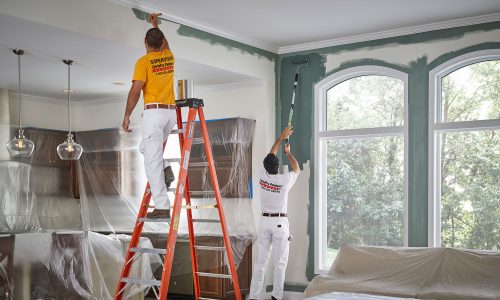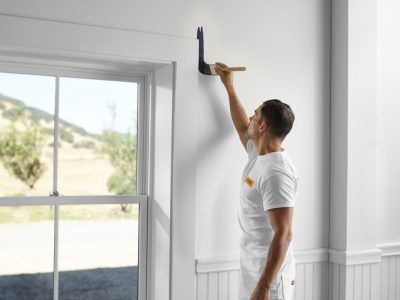Color Consultation in Lakewood: Expert Advice for Perfectly Coordinated Interiors
Color Consultation in Lakewood: Expert Advice for Perfectly Coordinated Interiors
Blog Article
Enhance Your Interior Decoration With Comprehensive Shade Consultation
The integration of shade examination right into interior style presents an unique chance to refine and elevate the aesthetic and psychological vibration of a room. By engaging with an experienced color expert, you can browse the complexities of shade selection, making certain that your choices not only complement architectural features however likewise resonate with individual style and mental effect.
Advantages of Shade Appointment

In addition, color assessment help in maximizing all-natural light and optimizing spatial understanding. Lighter hues can make a room appear more expansive, while darker tones develop an intimate setting. Cleveland Metro Painting Specialists. This tactical application of color can dramatically influence the general setting of any indoor space
Furthermore, specialist specialists possess a detailed understanding of ageless classics and present fads, making sure that the selected colors will continue to be enticing in time. This insight can conserve clients from expensive redesigns in the future. Color examination empowers clients by supplying them with a clear vision and instructions, fostering self-confidence in their layout options and ultimately leading to a much more gratifying and successful interior layout outcome.
Understanding Color Psychology
The relevance of shade psychology in indoor design can not be overstated, as it digs right into the psychological and emotional results that various shades can stimulate in people. Shades can affect mood, habits, and also efficiency, making them an important consideration in any style task.
For example, cozy shades such as red, orange, and yellow are frequently related to power and heat. They can stimulate feelings of enjoyment and convenience, making them ideal for social rooms like living kitchen areas or areas. Alternatively, awesome shades like blue, environment-friendly, and purple have a tendency to stimulate peace and serenity, making them excellent for bed rooms or reflection areas.
Furthermore, making use of neutral tones can develop a well balanced setting by permitting the bolder colors to stick out without overwhelming the senses. Recognizing these emotional impacts makes it possible for developers to create areas that not just look visually pleasing however also advertise psychological well-being.
Incorporating color psychology right into interior decoration includes a thoughtful selection of hues customized to the intended feature of each area, inevitably improving the general experience for its passengers. This understanding is vital for accomplishing a practical and harmonious indoor environment.
The Shade Wheel Explained
Recognizing the partnerships in between shades is essential for effective interior style, and the shade wheel functions as a useful device in this process. The shade wheel, created by Isaac Newton in the 17th century, highlights the range of colors prepared in a round style. It makes up key colors-- red, blue, and yellow-- that can not be developed by mixing various other shades. Second shades, developed by integrating primaries, include eco-friendly, orange, and purple. Tertiary colors arise from mixing a main and a second color, resulting in hues such as green and red-orange.
The color wheel helps developers comprehend the partnerships between shades, consisting of complementary, similar, and triadic systems. Corresponding colors, located contrary each other on the wheel, produce vivid contrasts that can stimulate an area.
Making use of the shade wheel in interior decoration not just boosts aesthetic appeal but additionally stimulates particular emotions and environments, making it a critical reference for shade consultation. Comprehending these connections inevitably equips designers to produce rooms that are both functional and aesthetically exciting.
Selecting the Right Palette
Usually, choosing the ideal combination is a crucial aspect in achieving a successful interior decoration job. A well-chosen color design can merge a space, boost its functions, and evoke desired feelings. To begin, think about the purpose of the room. Different rooms offer diverse features and call for combinations that mirror their designated use; for instance, tranquil shades such as soft blues or eco-friendlies work well in rooms, advertising relaxation.
Light can significantly modify exactly how shades show up, so it is important to assess the area at different times of the day. A harmonious palette needs to match these features, producing a cohesive appearance throughout the area.
When picking shades, utilize the 60-30-10 policy, which recommends that 60% of the area need to be a leading shade, 30% a second color, and 10% an accent shade. This proportion ensures equilibrium and visual interest (Cleveland Metro Painting Specialists). Sample shades on the wall surfaces prior to committing, as this enables you to see how the colors interact with one another and the overall atmosphere they create in your interior layout job.
Collaborating With a Shade Consultant

When collaborating with a shade specialist, the procedure usually starts with a first assessment. Throughout this meeting, you'll discuss your vision, preferences, and the existing aspects in your space. The expert will analyze your needs and may suggest certain color palettes that align with your objectives.
After establishing a direction, the expert will certainly offer examples and aesthetic aids to assist you visualize Extra resources the suggested shade plans. This action is critical, as colors can show up in a different way under varying have a peek at this site lighting conditions.
Furthermore, a color consultant can assist you in selecting complementary furnishings, art work, and accessories to integrate with your selected palette. By collaborating very closely, you can attain a polished aesthetic that elevates your insides and develops a welcoming atmosphere. Inevitably, the competence of a color professional can dramatically enhance the general influence of your layout job.
Final Thought
In summary, extensive shade examination works as an important device for enhancing interior decoration. By leveraging expert understanding of color psychology and spatial dynamics, a customized shade combination can be created to stimulate particular feelings and develop an unified environment. This calculated approach not just fosters a natural layout narrative however also mitigates the risk of costly redesigns. Inevitably, engaging with a shade consultant guarantees an informed and aesthetically pleasing outcome, boosting the general experience of the room.
By engaging with a skilled shade specialist, you can browse the intricacies of shade option, ensuring that your selections not only enhance building functions however additionally reverberate with individual style and mental impact. It comprises key colors-- red, blue, and yellow-- that can not be produced by blending other colors.The color wheel assists developers grasp the relationships between shades, consisting of corresponding, similar, and triadic systems.When choosing shades, make use of the 60-30-10 policy, which recommends that 60% of the room ought to be a dominant shade, 30% a second color, and 10% an accent color. By leveraging expert knowledge of shade psychology and spatial characteristics, a customized shade palette can be more information created to stimulate details emotions and create a harmonious atmosphere.
Report this page